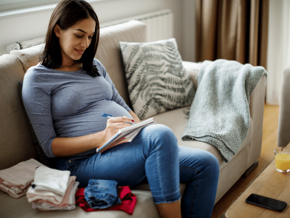
Everyone’s experience of giving birth is different, and it’s impossible to predict exactly what to expect. Being prepared with your hospital bag packed and a birth plan, while still allowing for unpredictability can go a long way toward setting realistic expectations and reducing any anxiousness. How your baby is delivered can depend on lots of factors, such as mum’s health and weight; baby’s health and weight; baby’s position in the womb or birth canal; and complications that might happen during labour. It's important to consult with your obstetrician or midwife to discuss individual circumstances, possible outcomes of each method of delivery, and to help you make the best choice for a safe and healthy birth experience.
When it comes to childbirth, understanding the key differences between vaginal delivery and caesarean section (c-section) can help expectant parents make informed decisions. The only key difference between these deliveries is that a vaginal delivery is nature’s method of childbirth through the birth canal. In contrast, a c-section involves surgical delivery, which may be necessary for various medical reasons. Other differences between the two methods of delivery are extremely individual, including labour duration, recovery time, as well as pain levels at different stages. No two births are the same.
Delivery through vaginal birth (natural birth)
Most babies are born vaginally, with or without some level of medical intervention such as pain relief, induction, forceps or vacuum extraction (also known as ventouse).
Vaginal birth involves the baby being born through the birth canal. Before that final push, there are a number of stages of labour to progress through. In summary, there will be early signs of labour that may include very subtle signs such as lower back ache, through to more obvious signs such as waters breaking or early contractions. When you experience these early signs, contact the hospital who will then help guide you on the best time to come in. Eventually your contractions will increase in frequency, duration and intensity as your cervix dilates, enough to deliver your baby.
Things to consider when it comes to a vaginal birth
- Pain relief - How much pain relief or other interventions you have will depend on your birth plan and choices, your needs, and your healthcare professional’s recommendations.
- Where will you give birth? Most births in Australia happen in a hospital. Birth centre or low-intervention hospital births only tend to be recommended for straightforward pregnancies and labours, where limited or no pain relief or intervention is required.
- A good thing to know about a vaginal birth - Your baby will be exposed to a number of beneficial bacteria through the birth canal, helping to kickstart their own immune system and support a healthy gut flora.
If your labour is delayed, progresses slowly, is painful or develops complications, you might need more help delivering your baby. This could include:
- Having your labour induced: Labour is induced when it is started artificially, before it spontaneously occurs. There are many reasons why women can be induced such as being overdue, having multiple births or having maternal high blood pressure. There are many ways of inducing labour:
- Artificially rupturing the membranes: This means ‘breaking the waters’ or rupturing the amniotic sac. This method is sometimes used in conjunction with other methods of induction.
- Prostaglandin: A gel may be inserted into the cervix with the aim of softening and thinning the walls of the cervix. This method may be individually used or in a combination with oxytocin.
- Oxytocin: Is a hormone naturally produced by the body which brings on contractions. A synthetic form of this hormone can be used in small doses if other methods of induction don’t work. It is given intravenously to bring on contractions.
- Having pain relief such as an epidural anaesthetic (an injection that delivers pain relief into your spine): Pain relief is an individual choice, and many mums-to-be have a ‘drug-free’ labour at the top of their birthing plan There will be pros and cons of not using drugs during labour, be informed about the pain relief options just in case and remain flexible during your labour – after all it’s the happy healthy mum and bub that we’re aiming for at the end.
- Having an assisted vaginal birth through the use of forceps (metal spoon-shaped instruments) or vacuum extraction to help get the baby out of the birth canal. If forceps or vacuum extraction is needed, you’ll probably also need an episiotomy (a shallow cut into the lower vagina to keep your tissue from tearing), which will be stitched up after the birth.
- Assistance with delivering the placenta - you can choose to receive an injection once your baby is born to help you deliver the placenta – or you can deliver naturally on your own.
As your labour progresses your doctor and/or midwife will speak to you about what interventions might be required.
Vaginal birth recovery
Remember, every woman's recovery is unique, and it's important to listen to your body and give yourself time to heal. If you have any specific concerns or questions, consult with your doctor or midwife for personalised advice. Below are some birth recovery tips:
- Rest and prioritise self-care: Allow yourself time to recover by getting plenty of rest, eating nutritious meals, and staying hydrated.
- Manage pain and discomfort: Take prescribed pain medication as directed, use ice packs or warm compresses on the perineal area for comfort.
- Practice good hygiene: Keep the perineal area clean and dry, use sanitary pads as needed, and be gentle wiping after using the bathroom.
- Support the pelvic floor: Perform gentle pelvic floor exercises (Kegels) to help strengthen and tone the muscles.
- Wear comfortable clothing: Opt for loose-fitting, breathable underwear and clothing to avoid irritation and promote comfort.
- Stay active: Gradually incorporate gentle exercises, such as walking, to promote blood circulation and aid in recovery.
- Seek emotional support: Connect with other new mothers, join support groups, or seek professional help if needed to address any emotional challenges or postpartum mood changes.
- Communicate with your healthcare professional: Attend follow-up appointments, discuss any concerns or questions, and follow their guidance for a smooth recovery.
Delivery through C-section (caesarean)
Around 38% of babies in Australia are born by caesarean birth, a surgical procedure commonly known as a c-section, or a caesar.
Many women today have a caesarean birth. This is a surgical operation that involves making a cut in the woman’s abdominal wall to take out the baby. Running along the topmost section of the pubic hairline, it leaves a scar that usually fades over time. Most caesarean birth happen with a spinal anaesthetic (epidural), meaning you will be awake and won’t be able to feel much from the waist down. A screen can be put up so you can’t see the operation, an incision is made across your lower tummy and your baby is pulled out of your womb. For some emergency caesareans you may have a general anaesthetic which puts you to sleep during the operation.
Things to consider about C-sections
Caesarean birth may be planned to take place before you go into labour (also called elective c-section) or unplanned (sometimes known as emergency c-section).
Your obstetrician may decide that an elective c-section is the safest way to deliver your baby, for example if:
- You are carrying multiple babies,
- You or your baby has an underlying health condition,
- You have a low-lying placenta, or
- Baby is in the breech position (feet rather than headfirst) toward the end of your pregnancy.
You might need an emergency c-section if:
- Your labour is progressing slowly,
- You’ve been induced but have not gone into labour
- There are concerns about you or your baby that happen during labour
If you’re anxious about having a scheduled or unplanned caesarean birth, start by talking to your healthcare professional and get tips from other mums.
Want to know more about c-sections? Check out c-sections: what to consider.
C-section recovery
Every person's recovery experience is different. For most women it takes at least 3 months to recover from a c-section. If you have any specific concerns or questions, consult with your healthcare professional for personalised advice and guidance throughout your C-section recovery journey. Below are some c-section recovery tips:
- Take it easy and rest: Allow yourself ample time to rest and recover. Avoid strenuous activities and lifting heavy objects for up to 6 weeks after your delivery.
- Follow post-operative care instructions: Adhere to the specific guidelines provided by your doctor, including hygienic wound care, medication management, and recommended activities.
- Support your incision: Use a pillow or your hands to support your incision when coughing, sneezing, or laughing to minimise discomfort.
- Gradually increase activity: Start with gentle walks and light stretching as advised by your doctor. Slowly increase activity levels over time.
- Manage pain and discomfort: Take prescribed pain medication as directed and use ice packs or heat therapy on the incision site to alleviate discomfort.
- Maintain good posture: Support your back with pillows when sitting or lying down to reduce strain on your incision.
- Eat a balanced diet: Focus on nutritious foods and stay hydrated to promote healing and provide energy for recovery.
- Seek emotional support: Reach out to loved ones, join support groups, or consider counselling to address any emotional challenges during the recovery period.
Attend follow-up appointments: Regularly visit your healthcare professional for post-operative check-ups and address any concerns or questions you may have.
Vaginal birth after a C-section
It is possible to have a vaginal birth after a previous c-section, known as a VBAC (vaginal birth after caesarean). Many women who have had a c-section can successfully deliver vaginally in subsequent pregnancies, depending on various factors such as the reason for the previous c-section, the type of uterine incision, and overall health. However, VBAC is not suitable for everyone, and it carries some risks. It is important to consult with your obstetrician to assess your individual situation, discuss the benefits and risks, and make an informed decision. They will monitor your pregnancy closely and provide guidance throughout the process to ensure the best possible outcome for you and your baby.
Frequently asked questions about giving birth
Why is it called caesarean section?
The term "caesarean section" is derived from the Latin word "caesus," which means "cut". According to historical accounts, the term "caesarean section" has been used for some time to describe the surgical method of delivering a baby when vaginal birth is not possible or safe for the mother or the baby.
What is a natural birth?
A natural birth, also known as a vaginal birth, is often referred to as the process of delivering a baby through the birth canal. For some, it may also mean without the use of medical interventions such as induction, epidural anaesthesia, or operative procedures like forceps or vacuum extraction. It emphasises the body's natural ability to give birth and allows for an unmedicated and physiologic process. It is important to note that every birth experience is unique, and the definition of a natural birth may vary from person to person based on individual preferences and circumstances.
Is a c section painful?
During a caesarean section (C-section), anaesthesia is administered to ensure that the mother does not feel pain during the procedure. There are different types of anaesthesia used, including epidural, spinal, or general anaesthesia, depending on the circumstances. While the surgical procedure itself is not painful, it is common to experience some discomfort or soreness at the incision site during the recovery period. However, pain management techniques such as medication and proper wound care can help alleviate post-operative pain. It's important to discuss pain management options and expectations with your obstetrician or midwife to ensure a comfortable and well-supported C-section experience.
Who holds the baby after a C-section?
After most C-sections, it is common for the medical team, including the obstetrician and nurses, to hold the baby briefly to ensure their safety and well-being. Once the initial assessments are done, the baby is placed on the mother's chest for skin-to-skin contact and bonding as soon as possible. The mother and her support person can actively participate in holding and nurturing their baby, promoting the important parent-infant bond. In some cases, where the mum has to remain in the operating theatre or a special recovery room, the baby will spend that time with dad or support person. The healthcare team will provide guidance and support to ensure a positive and loving experience for both the parent/s and baby.
What is the hardest part of giving birth?
The hardest part of giving birth varies markedly for everyone. Some common challenges include the intensity of labour contractions, the physical exertion required during pushing, and the potential for unexpected complications. The emotional and mental aspects, such as managing fear, anxiety, and the unknown, can also be challenging. Additionally, the recovery period following birth can present its own set of difficulties. It's important to remember that every birth experience is different, and support from healthcare professionals, loved ones, and proper self-care can help navigate these challenges.
Sources:
Pregnancy Birth & Baby Website. Accessed at https://www.pregnancybirthbaby.org.au/
Health Direct Website. Accessed at https://www.healthdirect.gov.au/maternity-care-in-australia






